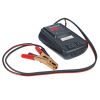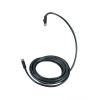Geotech Geosub Pump Controller
Features
- Converts AC Voltage to variable up to 300 watt DC voltage output
- Internal processor saves individual well parameters
- Optional DC to AC Inverter can be connected to avehicle battery
- Free ground shipping
- Expedited repair and warranty service
- Lifetime technical support
- More
Overview
The Gedotech Geosub Controller is designed specifically for use with Geotech's Geosub 2 Stainless Steel Pump. It provides a safe, conditioned variable DC output power from an AC power source. Built-in sensing gives the operator accurate and precise control over the pump during sampling events.
Battery Life
An average 1000-watt gasoline generator with 1 gallon of gasoline will operate the Geosub Controller and Geotech's sampling pump at full power for 18 hours continuously. Generally, much longer run times can be expected as the controller is used to reduce water flow for low-flow sampling.
Design
An easy-to-use programmable user interface with a bright display offers precise control over flow rates during groundwater sampling events. Site-specific settings and conditions can easily be stored and recalled for more efficient, repeatable sampling events. Rugged construction and easy-to-connect cables make setup and portability a breeze. In addition, the controller includes a user-set dry run protection feature.
Benefits
- Converts AC Voltage to variable up to 300-watt DC voltage output
- Short circuit protection for your safety
- Heavy duty rated power cable for years of service
- 2-line x 16-character wide temperature range alpha-numeric digital display
- Push button Up/Down control
- Internal processor saves individual well parameters
- Optional DC to AC Inverter can be connected to a vehicle battery
In The News
Supplying Seattle’s Drinking Water: Using Data Buoys to Monitor the Cedar River Municipal Watershed
Providing clean, safe, and reliable drinking water for the 1.6 million people in the greater Seattle area is a top priority for Seattle Public Utilities (SPU). With limited water supplies, SPU dedicates considerable resources to maintain its watersheds and mountain reservoirs. About 70 percent of Seattle Water comes from the Cedar River Municipal Watershed , and the other 30 percent comes from the South Fork Tolt River Watershed . [caption id="attachment_39574" align="alignnone" width="940"] Data buoy in Chester Morse Lake . (Credit: Kevin Johnson / Seattle Public Utilities) [/caption] Jamie Thompson, a fisheries biologist at SPU, monitors aquatic ecosystems centered on fish listed under the U.S. Endangered Species Act (ESA).
Read MoreData-Driven Advocacy on the Lower Deschutes River
Like many freshwater environments, the Deschutes River in Oregon is under pressure from development, pollution, and climate change. Many rivers, streams and lakes in the Deschutes Basin do not meet Oregon water quality standards –where state water quality monitoring assesses levels of bacteria, pH, dissolved oxygen, temperature, and fine sediment. Hannah Camel is the Water Quality Coordinator for the Deschutes River Alliance (DRA), a non-profit organization that focuses on the health of the lower 100 miles of the Deschutes River–the area most affected by human intervention. As a data-driven organization, the DRA has benefited from the installation of two NexSens X2 data loggers.
Read MoreExpanding the Port Everglades: Real-Time Monitoring of Water Quality Conditions from Planned Dredging Operation
The Port Everglades in Broward County, Florida, serves large trade vessels and cruiseliners and incoming and outgoing recreational boaters. However, as cargo ships become larger, the port must expand. A dredging project led by the US Army Corps of Engineers will substantially deepen and widen the port's navigation channel to accommodate larger Panamax cargo ships and modern cruise liners. As a result of this project, a large amount of sediment will be displaced into the water column. This suspended sediment may settle outside of the project area, burying benthic organisms like corals, and possibly carrying harmful particulates to other regions. [caption id="attachment_39497" align="aligncenter" width="2560"] A CB-950 and CB-25 deployed on site at Port Everglades.
Read More















